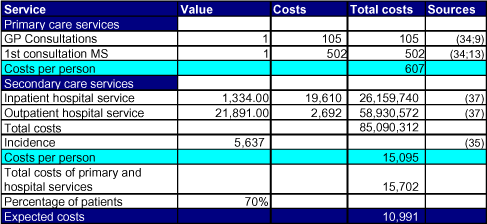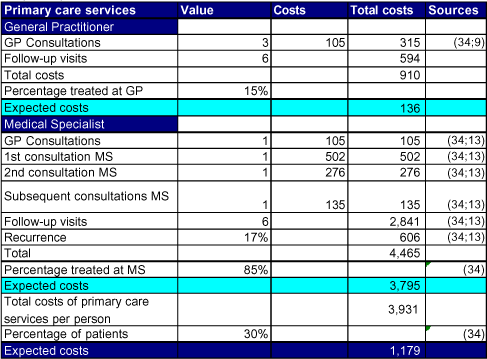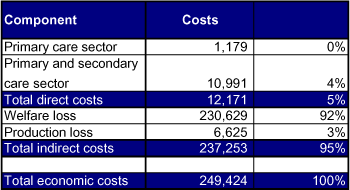|
Valuation of Chemical related Health Impacts 9 Skin cancerSkin cancer is defined as a malignant melanocytic tumor arising in the skin. Often skin cancer is divided into two main groups. (1) Non-melanoma and (2) melanoma skin cancer known as 'birthmark cancer'. Whereas no relation between chemicals and non-melanoma skin cancer exists, certain types of chemicals may induce non-melanoma skin cancer. Therefore the focus here will be on non-melanoma skin cancer17. The two main cancer groups within non-melanoma skin cancer are basal cell carcinoma and squamous cell carcinoma. The latter also called spinocelluaire carcinoma. US data shows that Squamous cell carcinoma is responsible for 20% of the non-melanoma skin cancer cases, and basal cell carcinoma is responsible for approximately 75% of the cases (Chen et al. (2001)). The remaining 5% are other types of non-melanoma skin cancers. The incidence of non-melanoma skin cancer in Denmark is increasing (Sundhedsstyrelsen 2003a; 2003b). Chemicals can induce squamous cell carcinoma. The available clinical data do not distinguish between the different types of non melanoma skin cancers (Sundhedsstyrelsen 2003a; 2003b). The reason for this is that registration of cancers is based on the ICD10. It is only registered whether the cancer is melanoma or non-melanoma and where it is located. This can be the reason why the international literature on costs of non-melanoma cancers is not segmented according to variety (e.g. Housman et al. (2003); Chen et al. (2001))). Furthermore, the literature on chemicals related to non-melanoma skin cancer is not segmented according to variety either (e.g. EU Commission (2003); Hansen et al. (1998)). Therefore, the costs estimations are made for the general group 'non-melanoma skin cancer'. 9.1 DefinitionNon-melanoma skin cancer is defined as C44 (Non-melanoma skin cancer) ICD-10 classification of diseases. It is assumed that all patients are treated within one year and that non-melanoma is not fatal. Even though a number of patients are likely to die from the non-melanoma skin cancer, Danish data on survival for non-melanoma skin cancer show a higher relative survival probability than the background population (Storm and Engholm (2002)). Therefore, fatality is not included in the analysis. 9.2 Chemicals associated with Skin CancerThe far most important reason for skin cancer in general is UV radiation of the skin from the sun. In relation to chemicals, there is no clinical evidence showing a direct relation between skin cancer and chemicals. However, animal studies and observational human studies indicate that exposure to certain chemicals, such as coal tar pitch, mineral oil, and creosote increases the relative risk of skin cancer (Merck (1998); Andersen et al. (1994)). 9.3 Direct health care costsEstimation of direct health care costs are based partly on the incidence based approach and partly on the prevalence based approach. Costs for hospital services are based on the prevalence approach where as costs for primary care services are based on the incidence approach. According to Drzewiecki (2003), 30% of the patients are treated in the primary care sector only. 70% of the patients are visited in the primary care sector and referred to treatment in the secondary sector (hospital sector). Costs for patients treated in the hospital sectorCosts of hospital services are estimated from the average number of discharges for inpatient and outpatient hospital services (Table 9-1). Table 9-1 Total treatment costs for patients with non-melanoma skin cancer treated in the hospital sector (DKK 2002 values)
Sources The first number refers to the source for the number of services or percentage. The second number refers to the source for the cost per service. See appendix 1 with list of sources for the calculations. Before a patient is referred to a hospital, the patient will on average have one consultation at the GP and one at the MS. Total costs of hospital services are approximately DKK 85 millions. The costs per person are found by dividing total hospital costs with the incidence for non-melanoma skin cancer. Hence, of the persons admitted to the hospitals, the costs per person are approximately DKK 15,000. Total expected costs are found by multiplying total costs with the percentage of patients referred to hospitals. Hence, total expected costs for persons treated at hospitals are 10,991 per person. Costs of treating a person in the primary care sector are estimated using expert input as no data regarding use of these services are available (Table 9-2). Table 9-2 Total direct costs for patients with non-melanoma skin cancer treated in the primary care sector (DKK 2002 values)
Sources The first number refers to source for the number of services. The second number refers to source for the costs per service. See appendix 1 with list of sources for the calculations. 15% of the patients treated in the primary care sector are treated at the GP whereas 85% are treated at the MS (Drzewiecki (2003)). In both cases, the patient will have 6 follow-up visits over the following 3 years. Using a discount rate of 3%, the costs of 6 follow-up visits are DKK 594 and 2,841 for GP and MS respectively. Furthermore, 1/6 of the patients will have recurrence of the non-melanoma skin cancer (Drzewiecki (2003)). Recurrence is assumed on average to take place in the second year following the diagnosis. Using a discount rate of 3%, costs of recurrence are estimated to be DKK 606 ((1/6 * 2,841)/1.032). Total costs for patients treated in the primary care sector are DKK 3,795. Hence, expected costs are DKK 1,179 when taking into account that this is only 30% of the patients. Total direct costs are estimated by adding costs of primary and hospital services together (Table 9-3). Table 9-3 Total direct costs per person with non-melanoma skin cancer (DKK 2002 values)
Total expected costs per person are estimated to be approximately DKK 12,000. 9.4 Individual welfare lossCompared to other types of cancer many cases of non-fatal skin cancer are relatively easily cured without to much pain and suffering for the patient. Furthermore the average duration of the disease course is relatively short (less than one year). One of the elements to be included in the individual welfare loss of skin cancer is the risk of permanent scars. According to Drzewiecki (2003) app. 70% of all inpatient treatments results in permanent scars. It is estimated that 70-75% of the cases appear in the face/neck and following this, scars will be difficult to cover. Only very few studies on the WTP to avoid skin cancer are available. This include following as best options for benefit transfer:
9.5 Production lossNo statistics on the degree of absence due to skin cancer is available. Based on data on the number of various treatments combined with expert judgement (Drzewiecki (2003)), the number of days of sickness following Skin cancer has been estimated as seen in Table 9-4 below. Table 9-4: number of days lost per skin cancer patient
The number on lost days of production is a result of following data and assumptions: Each inpatient hospital service of 4.5 days in average, and the incidence of hospitalization in connection with skin cancer is 23.7%. In addition to this it is assumed that each hospitalization is followed by a period of illness of 14 days in average ((Drzewiecki (2003)). It is further assumed that all days of illness may fall on working days as well as non-working days, except for one day of hositalization, namely the day of operation, which will always fall on a working day. Each patient receives outpatient hospital services 3.9 times in average. In average, one of these times is assumed to include operation. Each outpatient operation is assumed to result in additional 4 days of illness at home ((Drzewiecki (2003)). Each time of outpatient hospital service is assumed to result in a day absence from work. The 4 additional days may fall on working as well as non-working days. Each patient has 9 visits at the GP in average. It is here assumed to result in 3 days of absence from work. With a production loss value of DKK 533 per day the average production loss value is DKK 6,625 per skin cancer patient. 9.6 Unit cost estimateThe total unit cost estimate is seen in Table 9-5 below. The total unit cost of skin cancer is DKK249,424. Again, the welfare loss is seen to be the far most important cost element contributing with 92% of the total costs. However, as described above, the estimation of the individual welfare loss is very uncertain, which makes the total unit cost estimate very uncertain as well. Table 9-5: Unit cost estimate, non-melanoma skin cancer, DKK, 2002-prices
Primary care sector are costs for those patients only treated in the primary sector Footnotes17 Indirectly, chemicals reducing the ozone layer may cause both types of skin cancer through increased UV radiation of the skin.
|




